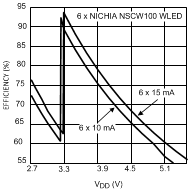SNVS550E September 2009 – January 2017 LP5523
PRODUCTION DATA.
- 1 Features
- 2 Applications
- 3 Description
- 4 Revision History
- 5 Pin Configuration and Functions
-
6 Specifications
- 6.1 Absolute Maximum Ratings
- 6.2 ESD Ratings
- 6.3 Recommended Operating Conditions
- 6.4 Thermal Information
- 6.5 Electrical Characteristics
- 6.6 Charge Pump Electrical Characteristics
- 6.7 LED Driver Electrical Characteristics
- 6.8 LED Test Electrical Characteristics
- 6.9 Logic Interface Characteristics
- 6.10 Recommended External Clock Source Conditions
- 6.11 Serial Bus Timing Parameters (SDA, SCL)
- 6.12 Typical Characteristics
-
7 Detailed Description
- 7.1 Overview
- 7.2 Functional Block Diagram
- 7.3 Feature Description
- 7.4 Device Functional Modes
- 7.5 Programming
- 7.6 Register Maps
- 8 Application and Implementation
- 9 Power Supply Recommendations
- 10Layout
- 11Device and Documentation Support
- 12Mechanical, Packaging, and Orderable Information
Package Options
Mechanical Data (Package|Pins)
- YFQ|25
Thermal pad, mechanical data (Package|Pins)
Orderable Information
6 Specifications
6.1 Absolute Maximum Ratings
over operating free-air temperature range (unless otherwise noted)(1)(2)(3)| MIN | MAX | UNIT | ||
|---|---|---|---|---|
| VDD | –0.3 | 6 | V | |
| Voltage on D1 to D9, C1−, C1+, C2–, C+, VOUT | –0.3 | VDD + 0.3 V with 6 V maximum | V | |
| Continuous power dissipation | Internally limited | |||
| Junction temperature, TJ-MAX | 125 | °C | ||
| Storage temperature, Tstg | –65 | 150 | °C | |
(1) Stresses beyond those listed under Absolute Maximum Ratings may cause permanent damage to the device. These are stress ratings only, which do not imply functional operation of the device at these or any other conditions beyond those indicated under Recommended Operating Conditions. Exposure to absolute-maximum-rated conditions for extended periods may affect device reliability.
(2) If Military/Aerospace specified devices are required, contact the TI Sales Office/Distributors for availability and specifications.
(3) All voltages are with respect to the potential at the GND pin.
6.2 ESD Ratings
| VALUE | UNIT | ||||
|---|---|---|---|---|---|
| V(ESD) | Electrostatic discharge | Human-body model (HBM), per ANSI/ESDA/JEDEC JS-001(1) | All pins except D1 to D9 | ±2500 | V |
| Pins D1 to D9 | ±8000 | ||||
| Charged-device model (CDM), per JEDEC specification JESD22-C101(2) | All pins | ±1000 | |||
| Machine model | All pins | 250 | |||
(1) JEDEC document JEP155 states that 500-V HBM allows safe manufacturing with a standard ESD control process.
(2) JEDEC document JEP157 states that 250-V CDM allows safe manufacturing with a standard ESD control process.
6.3 Recommended Operating Conditions
over operating free-air temperature range (unless otherwise noted)(1)(2)| MIN | MAX | UNIT | ||
|---|---|---|---|---|
| VDD input voltage | 2.7 | 5.5 | V | |
| Voltage on logic pins (input or output pins) | 0 | VDD | V | |
| Recommended charge pump load current | 0 | 100 | mA | |
| Junction temperature, TJ | –30 | 125 | °C | |
| Ambient temperature, TA (2) | –30 | 85 | °C | |
(1) All voltages are with respect to the potential at the GND pin.
(2) In applications where high power dissipation and/or poor package thermal resistance is present, the maximum ambient temperature may have to be derated. Maximum ambient temperature (TA-MAX) is dependent on the maximum operating junction temperature (TJ-MAX-OP = 125°C), the maximum power dissipation of the device in the application (PD-MAX), and the junction-to ambient thermal resistance of the part/package in the application (RθJA), as given by the following equation: TA-MAX = TJ-MAX-OP – (RθJA × PD-MAX).
6.4 Thermal Information
| THERMAL METRIC(1) | LP5523 | UNIT | |
|---|---|---|---|
| YFQ (DSBGA) | |||
| 25 PINS | |||
| RθJA(2) | Junction-to-ambient thermal resistance | 60.9 | °C/W |
| RθJC(top) | Junction-to-case (top) thermal resistance | 0.4 | °C/W |
| RθJB | Junction-to-board thermal resistance | 9.9 | °C/W |
| ψJT | Junction-to-top characterization parameter | 0.2 | °C/W |
| ψJB | Junction-to-board characterization parameter | 10.0 | °C/W |
(1) For more information about traditional and new thermal metrics, see Semiconductor and IC Package Thermal Metrics.
(2) Junction-to-ambient thermal resistance is highly application and board-layout dependent. In applications where high maximum power dissipation exists, special care must be paid to thermal dissipation issues in board design.
6.5 Electrical Characteristics
Unless otherwise noted: typical limits are for TA = 25°C; minimum and maximum limits apply over the operating ambient temperature range (−30°C < TA < +85°C), specifications apply to the Functional Block Diagram with: VDD = 3.6 V, VEN = 1.65 V, COUT = 1 µF, CIN = 1 µF, C1–2 = 0.47 µF.(1)(2)(3)(4)| PARAMETER | TEST CONDITIONS | MIN | TYP | MAX | UNIT | |
|---|---|---|---|---|---|---|
| IVDD | Standby supply current | VEN = 0V, CHIP_EN=0 (bit), external 32-kHz clock running or not running | 0.2 | µA | ||
| CHIP_EN=0 (bit), external 32 kHz clock not running | 1 | µA | ||||
| CHIP_EN=0 (bit), external 32 kHz clock running | 1.4 | µA | ||||
| Normal mode supply current | External 32-kHz clock running, charge pump and current source outputs disabled | 0.6 | mA | |||
| Charge pump in 1× mode, no load, current source outputs disabled | 0.8 | mA | ||||
| Charge pump in 1.5× mode, no load, current source outputs disabled | 1.8 | mA | ||||
| Power-save mode supply current | External 32-kHz clock running | 10 | µA | |||
| Internal oscillator running | 0.6 | mA | ||||
| ƒOSC | Internal oscillator frequency accuracy | –4% | 4% | |||
| –7% | 7% | |||||
(1) The Electrical Characteristics tables list ensured specifications under Recommended Operating Conditions except as otherwise modified or specified by the Electrical Characteristics conditions and/or notes. Typical specifications are estimations only and are not ensured.
(2) All voltages are with respect to the potential at the GND pin.
(3) Minimum and maximum limits are ensured by design, test, or statistical analysis.
(4) Low-ESR surface-mount ceramic capacitors (MLCCs) used in setting electrical characteristics.
6.6 Charge Pump Electrical Characteristics
Unless otherwise noted: typical limits are for TA = 25°C; minimum and maximum limits apply over the operating ambient temperature range (−30°C < TA < +85°C). See(1)(2)(3)| PARAMETER | TEST CONDITIONS | MIN | TYP | MAX | UNIT | |
|---|---|---|---|---|---|---|
| ROUT | Charge pump output resistance | Gain = 1.5× | 3.5 | Ω | ||
| Gain = 1× | 1 | |||||
| ƒSW | Switching frequency | 1.25 | MHz | |||
| IGND | Ground current | Gain = 1.5× | 1.2 | mA | ||
| Gain = 1× | 0.3 | |||||
| tON | VOUT turnon time (4) | VDD = 3.6 V, IOUT = 60 mA | 100 | µs | ||
(1) The Electrical Characteristics tables list ensured specifications under Recommended Operating Conditions except as otherwise modified or specified by the Electrical Characteristics conditions and/or notes. Typical specifications are estimations only and are not ensured.
(2) All voltages are with respect to the potential at the GND pin.
(3) Minimum and maximum limits are ensured by design, test, or statistical analysis.
(4) Turnon time is measured from the moment the charge pump is activated until the VOUT crosses 90% of its target value.
6.7 LED Driver Electrical Characteristics
Unless otherwise noted limits apply for TA = 25°C. See(1)(2)(3)| PARAMETER | TEST CONDITIONS | MIN | TYP | MAX | UNIT | |
|---|---|---|---|---|---|---|
| ILEAKAGE | Leakage current (outputs D1 to D9) | PWM = 0% | 0.1 | 1 | µA | |
| IMAX | Maximum source current | Outputs D1 to D9 | 25.5 | mA | ||
| IOUT | Output current accuracy (4) | Output current set to 17.5 mA | −4% | 4% | ||
| −30°C < TA < +85°C | –5% | 5% | ||||
| IMATCH | Matching (4) | Output current set to 17.5 mA | 1% | 2.5% | ||
| ƒLED | LED switching frequency | 312 | Hz | |||
| VSAT | Saturation voltage (5) | Output current set to 17.5 mA | 45 | 100 | mV | |
(1) The Electrical Characteristics tables list ensured specifications under Recommended Operating Conditions except as otherwise modified or specified by the Electrical Characteristics conditions and/or notes. Typical specifications are estimations only and are not ensured.
(2) All voltages are with respect to the potential at the GND pin.
(3) Minimum and maximum limits are ensured by design, test, or statistical analysis.
(4) Output current accuracy is the difference between the actual value of the output current and programmed value of this current. Matching is the maximum difference from the average. For the constant current outputs on the part (D1 to D9), the following are determined: the maximum output current (MAX), the minimum output current (MIN), and the average output current of all outputs (AVG). Two matching numbers are calculated: (MAX – AVG) / AVG and (AVG – MIN) / AVG. The largest number of the two (worst case) is considered the matching figure. Note that some manufacturers have different definitions in use.
(5) Saturation voltage is defined as the voltage when the LED current has dropped 10% from the value measured at VOUT – 1 V.
6.8 LED Test Electrical Characteristics
Unless otherwise noted limits apply for TA = 25°C. See(1)(2)(3)| PARAMETER | TEST CONDITIONS | MIN | TYP | MAX | UNIT | |
|---|---|---|---|---|---|---|
| LSB | Least significant bit | 30 | mV | |||
| EABS | Total unadjusted error(4) | VIN_TEST = 0 V to VDD | < ±3 | ±4 | LSB | |
| tCONV | Conversion time | 2.7 | ms | |||
| VIN_TEST | DC voltage range | 0 | 5 | V | ||
(1) The Electrical Characteristics tables list ensured specifications under Recommended Operating Conditions except as otherwise modified or specified by the Electrical Characteristics conditions and/or notes. Typical specifications are estimations only and are not ensured.
(2) All voltages are with respect to the potential at the GND pin.
(3) Minimum and maximum limits are ensured by design, test, or statistical analysis.
(4) Total unadjusted error includes offset, full-scale, and linearity errors.
6.9 Logic Interface Characteristics
Unless otherwise noted: typical limits are for TA = 25°C; minimum and maximum limits apply over the operating ambient temperature range (−30°C < TA < +85°C).See(1)(2)(3)(4)| PARAMETER | TEST CONDITIONS | MIN | TYP | MAX | UNIT | |
|---|---|---|---|---|---|---|
| LOGIC INPUT EN | ||||||
| VIL | Input low level | 0.5 | V | |||
| VIH | Input high level | 1.2 | V | |||
| II | Input current | −1 | 1 | µA | ||
| tDELAY | Input delay(4) | 2 | µs | |||
| LOGIC INPUT SCL, SDA, TRIG, CLK, ASEL0, ASEL1 | ||||||
| VIL | Input low level | 0.2 × VEN | V | |||
| VIH | Input high level | 0.8 × VEN | V | |||
| II | Input current | −1 | 1 | µA | ||
| LOGIC OUTPUT SDA, TRIG, INT | ||||||
| VOL | Output low level | IOUT = 3 mA (pullup current) | 0.3 | 0.5 | V | |
| IL | Output leakage current | VOUT = 2.8 V | 1 | µA | ||
| LOGIC OUTPUT GPO | ||||||
| VOL | Output low level | IOUT = 3 mA | 0.3 | 0.5 | V | |
| VOH | Output high level | IOUT = −2 mA | VDD − 0.5 | VDD − 0.3 | ||
| IL | Output leakage current | VOUT = 2.8 V | 1 | µA | ||
(1) The Electrical Characteristics tables list ensured specifications under Recommended Operating Conditions except as otherwise modified or specified by the Electrical Characteristics conditions and/or notes. Typical specifications are estimations only and are not ensured.
(2) All voltages are with respect to the potential at the GND pin.
(3) Minimum and maximum limits are ensured by design, test, or statistical analysis.
(4) The I2C host must allow at least 500 µs before sending data to the LP5523 after the rising edge of the enable line.
6.10 Recommended External Clock Source Conditions
Unless otherwise noted limits apply for TA = 25°C. See(1)(2)(3) (4)(5)| MIN | NOM | MAX | UNIT | |||
|---|---|---|---|---|---|---|
| LOGIC INPUT CLK | ||||||
| ƒCLK | Clock frequency | 32.7 | kHz | |||
| tCLKH | High time | 6 | µs | |||
| tCLKL | Low time | 6 | µs | |||
| tr | Clock rise time, 10% to 90% | 2 | µs | |||
| tf | Clock fall time, 90% to 10% | 2 | µs | |||
(1) The Electrical Characteristics tables list ensured specifications under Recommended Operating Conditions except as otherwise modified or specified by the Electrical Characteristics conditions and/or notes. Typical specifications are estimations only and are not ensured.
(2) All voltages are with respect to the potential at the GND pin.
(3) Minimum and maximum limits are ensured by design, test, or statistical analysis.
(4) Specification is ensured by design and is not tested in production. VEN = 1.65 V to VDD.
(5) The ideal external clock signal for the LP5523 is a 0 V to VEN 25% to 75% duty-cycle square wave. At frequencies above 32.7 kHz, program execution is faster, and at frequencies below 32.7 kHz program execution is slower.
6.11 Serial Bus Timing Parameters (SDA, SCL)
Unless otherwise noted limits apply for TA = 25°C. See(1)(2)(3) (2)(3)| MIN | MAX | UNIT | ||
| fSCL | Clock frequency | 400 | kHz | |
| 1 | Hold time (repeated) START condition | 0.6 | µs | |
| 2 | Clock low time | 1.3 | µs | |
| 3 | Clock high time | 600 | ns | |
| 4 | Setup TIME FOR A REPEATED START condition | 600 | ns | |
| 5 | Data hold time | 50 | ns | |
| 6 | Data setup time | 100 | ns | |
| 7 | Rise time of SDA and SCL | 20+0.1 Cb | 300 | ns |
| 8 | Fall time of SDA and SCL | 15+0.1 Cb | 300 | ns |
| 9 | Set-up time for STOP condition | 600 | ns | |
| 10 | Bus free time between a STOP and a START condition | 1.3 | µs | |
| Cb | Capacitive load parameter for each bus line. Load of one picofarad corresponds to one nanosecond. |
10 | 200 | ns |
(1) The Electrical Characteristics tables list ensured specifications under Recommended Operating Conditions except as otherwise modified or specified by the Electrical Characteristics conditions and/or notes. Typical specifications are estimations only and are not ensured.
(2) Minimum and maximum limits are ensured by design, test, or statistical analysis.
(3) Specification is ensured by design and is not tested in production. VEN = 1.65 V to VDD.
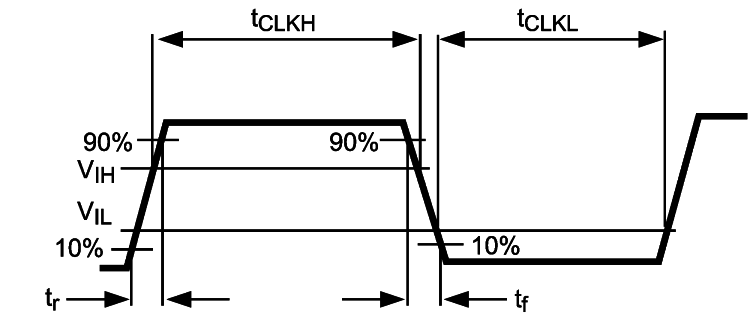 Figure 1. External Clock Signals
Figure 1. External Clock Signals
 Figure 2. Serial Bus Timing Diagram
Figure 2. Serial Bus Timing Diagram
6.12 Typical Characteristics
Unless otherwise specified: VDD = 3.6 V, CIN = COUT = 1 µF, C1 = C2 = 0.47 µF, TA = 25°C; CIN, COUT, C1, C2: low-ESR surface-mount ceramic capacitors (MLCCs) used in setting electrical characteristics.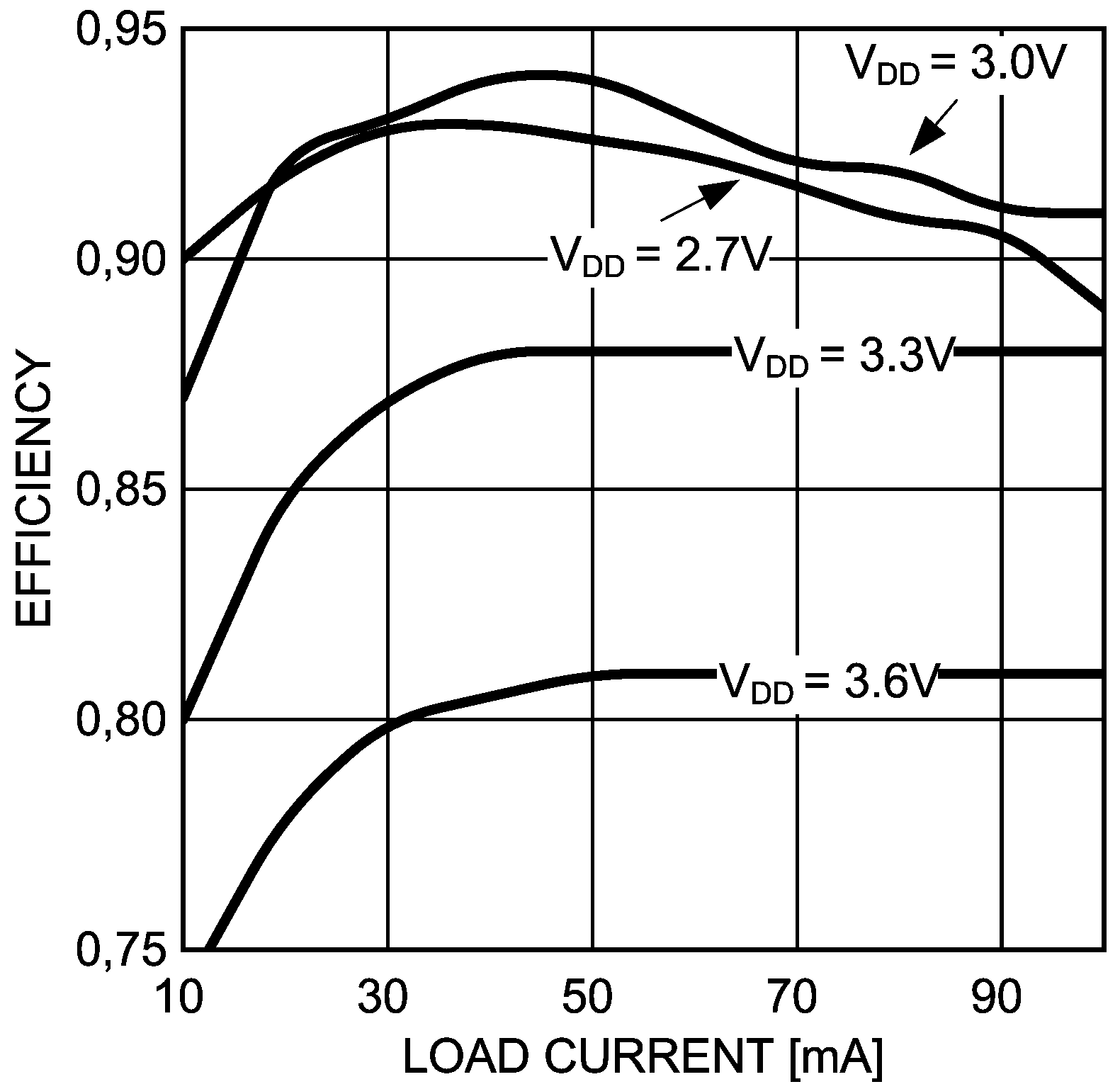
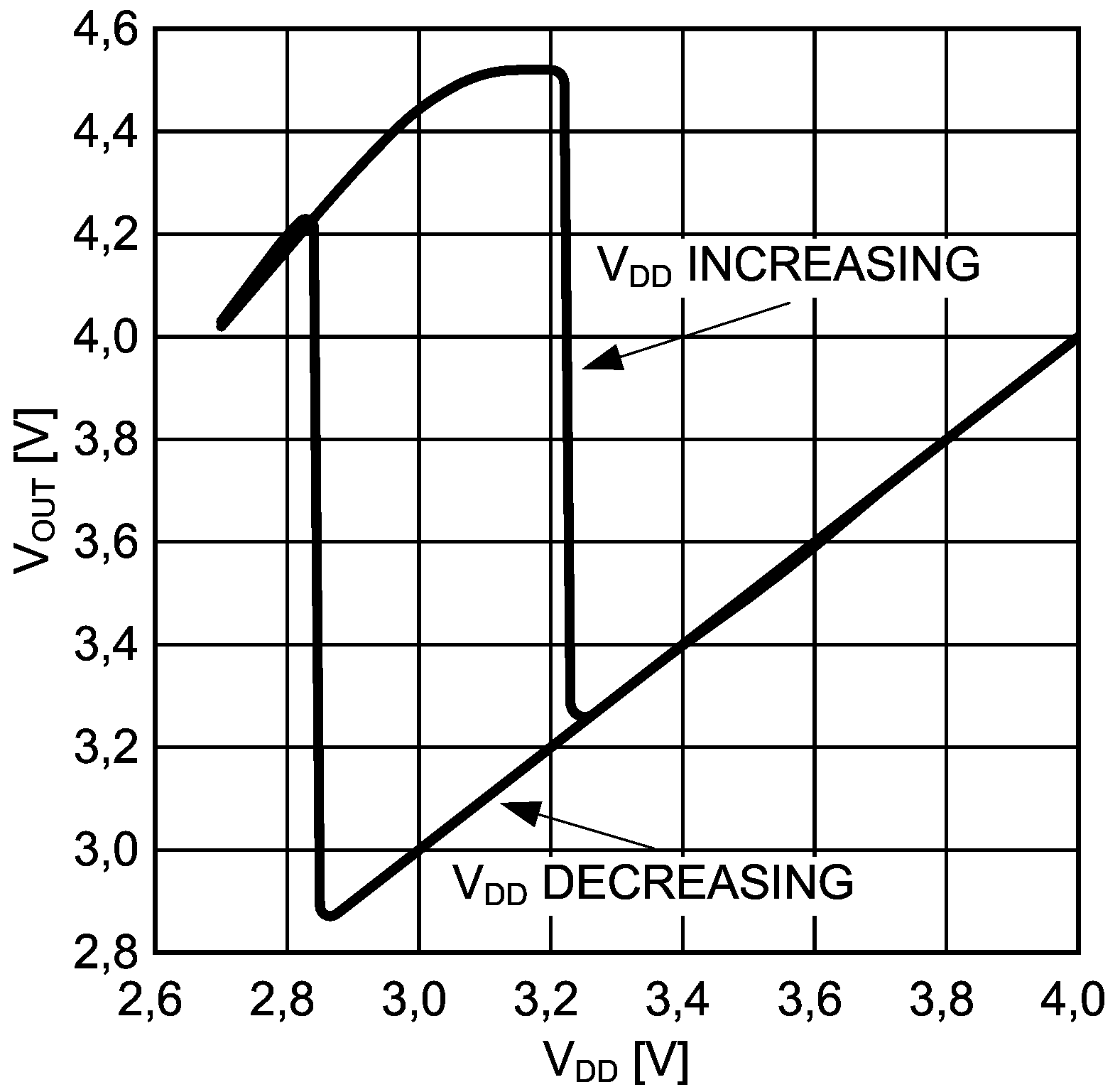
| 6 × 1-mA Load | 6 Nichia NSCW100 WLEDs on D1 To D6 | |
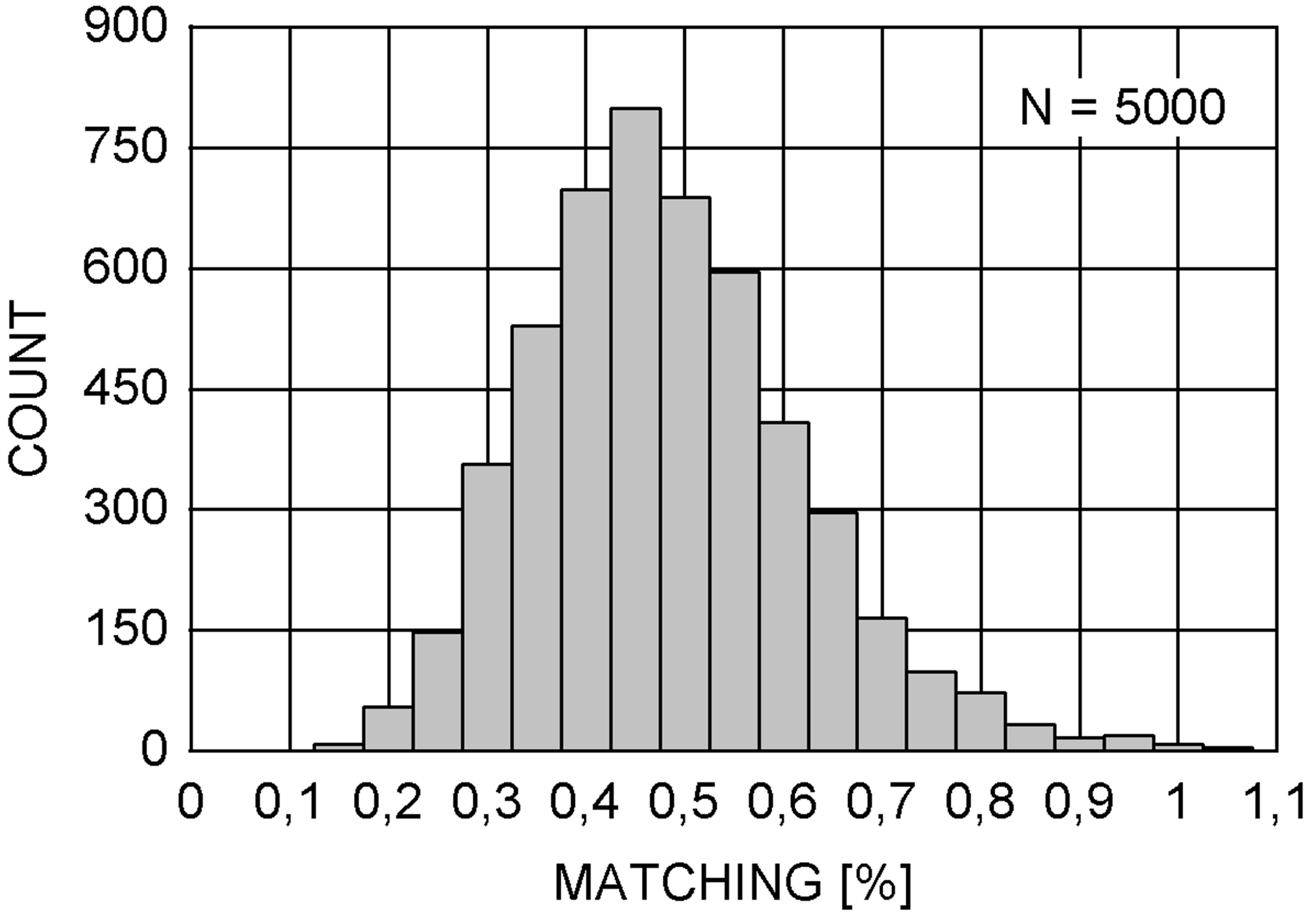
| 17.5-mA Current | ||
| See note 4 in LED Driver Electrical Characteristics | ||
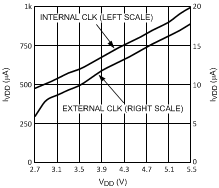
| Charge Pump In 1× Mode | ||
| If the charge pump is OFF the supply current is even lower. |
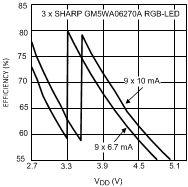
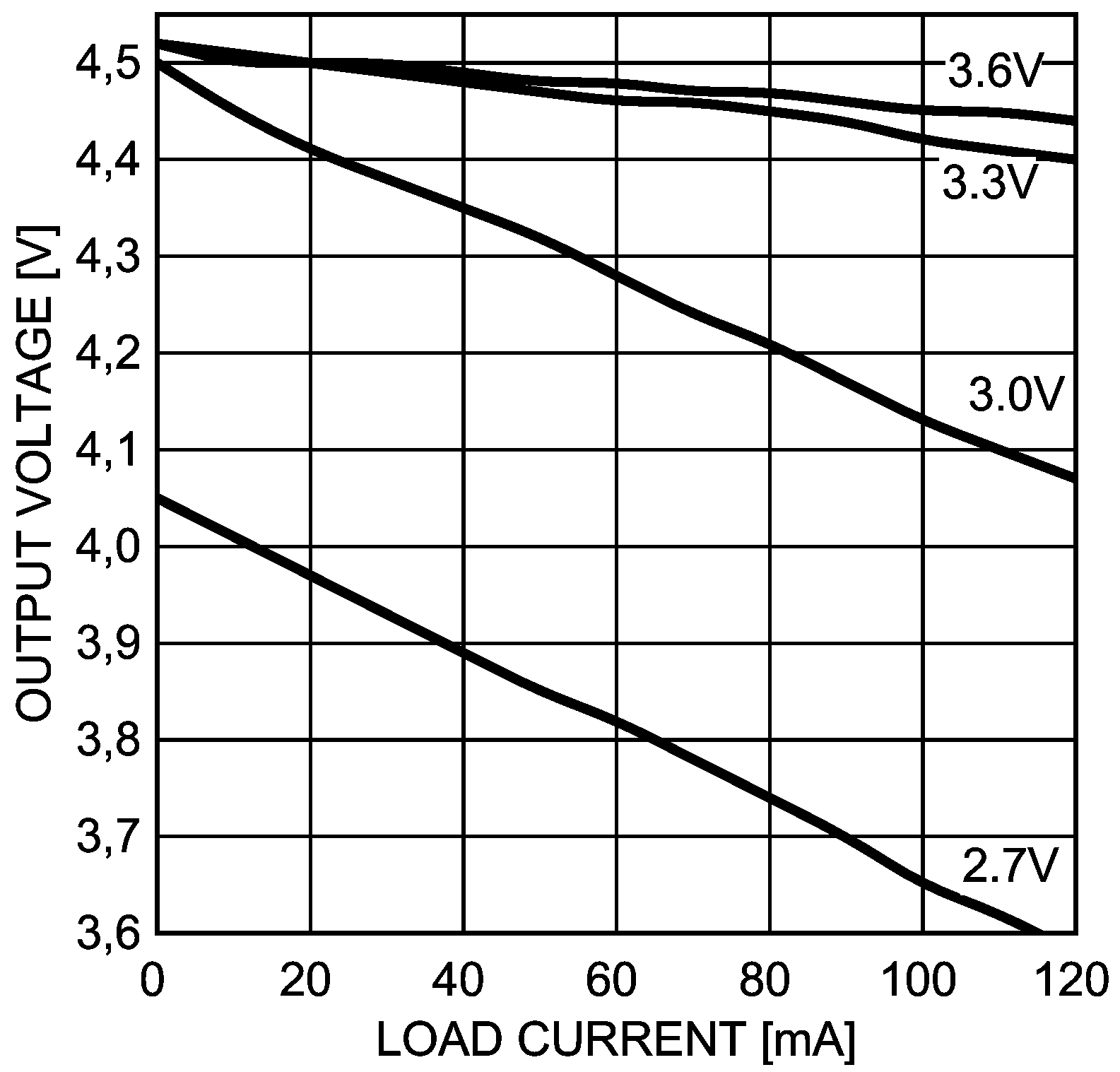
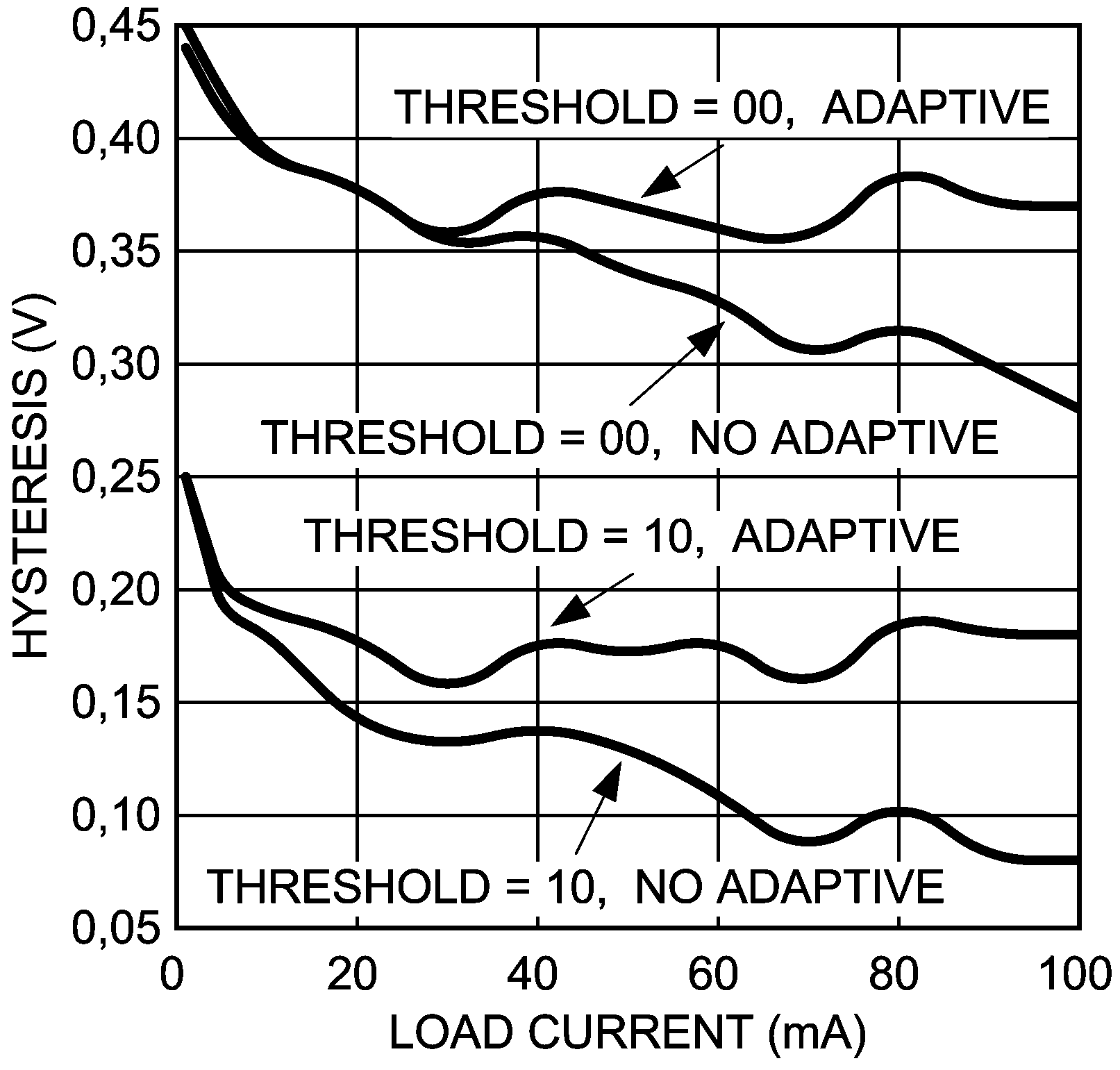
| Load = 6 × Nichia NSCW100 WLEDs on D1 To D6 at 100% PWM |
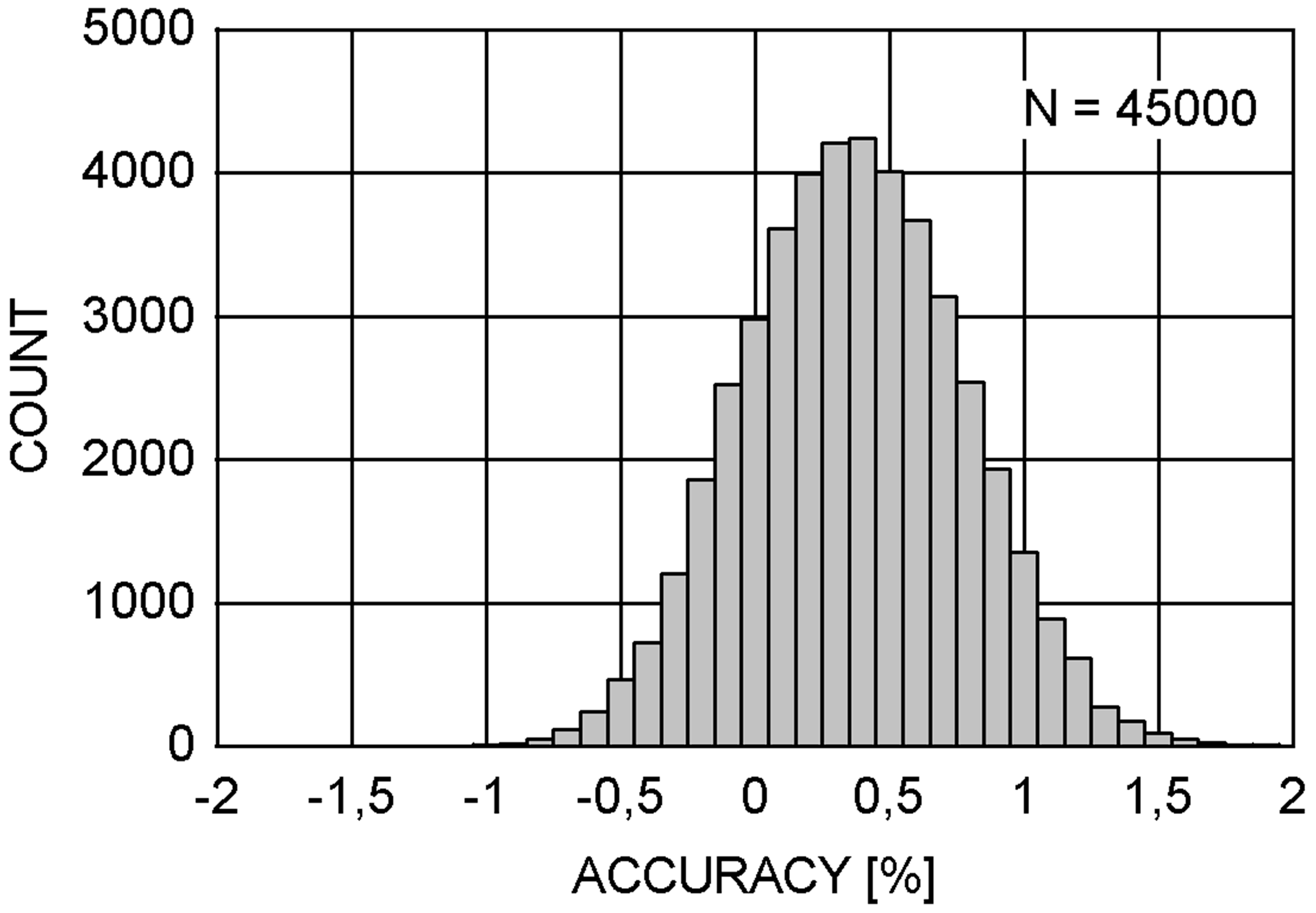
| 17.5-mA Current | ||
| See note 4 in LED Driver Electrical Characteristics | ||
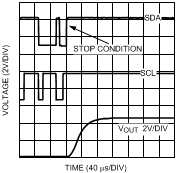
| VDD = 3.6 V | ILOAD = 60 mA |
Charge-Pump Start-up Waveform
